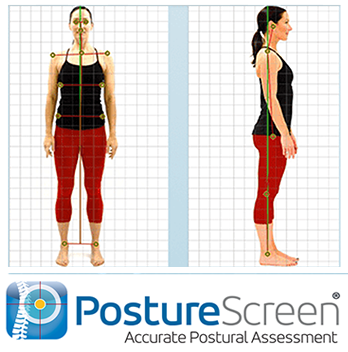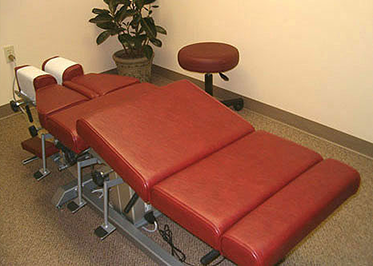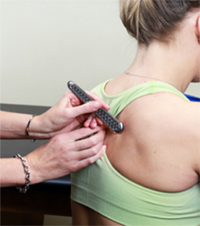Our Services
Digital Posture Analysis

The PostureScreen™ System is an assessment tool that is used in our office to analyze posture. The program uses digital photography and innovative computerized technology to create a report that outlines postural deviations and recommends a personalized exercise program. The report and exercise program is used to establish a rehabilitation program that is specific to each individual patient. The system is completed during the initial visit as part of the new patient examination and is used again during re-examination to measure correction.
Drop Table Adjusting
"The development of the drop-adjusting table has revolutionized the utilization of Chiropractic Adjusting within the profession."--Dr. Wayne Zemelka

At the Spinal Health and Wellness Center, we utilize the Segmental Drop System for Chiropractic Adjusting. This system utilizes a precision adjusting table with individual drop pieces. The drop pieces on the table create a force in the joint and/or soft tissue that produces the desired change in spinal alignment. This technique reduces the force needed to adjust the spine, which reduces the reaction to the patient. The result of this technique is a precisely directed low force adjustment used to improve the alignment of the spine.
Chiropractic has been shown to be highly effective in the diagnosis and treatment of tension and cervicogenic headaches, the two most common types, as they both result from disturbances of the bones, joints, muscles, nerves and blood vessels that relate to the neck, scalp, head and face.
Trigger Point Therapy
"It can be a mistake to assume the problem is at the place where you feel the pain..."
A myofascial trigger point is a group of muscle fibers that stay in a contraction without relaxing. A trigger point in a muscle could be causing pain or it could manifest no pain at all unless touched. A trigger point has the ability to send pain into other areas of the body – this is called referred pain. Trigger point researchers believe that everyday pain is caused by myofascial trigger points and that ignorance of that basic concept could inevitably lead to false diagnoses and the ultimate failure to deal effectively with pain (Travell and Simons 1999, 12-14). In the Trigger Point Manual, Travell and Simons list 24 examples of mistaken diagnoses that are likely to be made when the physician is unaware that myofascial trigger points may be to blame. Trigger points can develop in any of the 200 pairs of muscles in the body. Trigger points develop as a result of activities that damage or overload muscles such as accidents, falls, lifting or carrying heavy loads, exercising when out of condition, abnormal posture and/or repetitive activities. Trigger Point Therapy is a type of deep tissue massage that works by stretching the muscle fibers of the trigger point which causes the fibers to relax. This therapy is used in our office as a supplement to the chiropractic adjustment and rehabilitative techniques.
Instrument Assisted Soft Tissue Mobilization (IASTM):
 Instrument Assisted Soft Tissue Mobilization is a non-invasive treatment technique that uses specifically designed surgical-grade stainless steel tools. The instruments are used to facilitate the healing of soft tissues such as ligaments, tendons and muscles. The benefits of Instrument Assisted Soft Tissue Mobilization are to reduce scar tissue and adhesions, increase range of motion and flexibility, decrease pain, and increase tissue healing and recovery. Most patients start to see significant results in just a few sessions.
Instrument Assisted Soft Tissue Mobilization is a non-invasive treatment technique that uses specifically designed surgical-grade stainless steel tools. The instruments are used to facilitate the healing of soft tissues such as ligaments, tendons and muscles. The benefits of Instrument Assisted Soft Tissue Mobilization are to reduce scar tissue and adhesions, increase range of motion and flexibility, decrease pain, and increase tissue healing and recovery. Most patients start to see significant results in just a few sessions.
Spinal Rehabilitation
"Treatment should favor an approach that is conservative but active, and aims both to restore function quickly and prevent future episodes." —The Physician and Sports Medicine, 1997

The purpose of spinal rehabilitation is to restore muscle balance/symmetry, increase muscle strength, and increase muscle endurance. Overtime, muscles surrounding the spine become imbalanced. Some muscles become tight and tense while others become stretched and weak. These muscle imbalances predispose people to musculoskeletal problems. When muscles become imbalanced they alter movement of spinal joints leading to joint fixation or instability. Without restoring muscle balance and symmetry, joint imbalances will remain. This is the logic behind using spinal rehabilitation techniques in addition to the spinal adjustments. A joint that is surrounded by imbalanced muscles will continue to become misaligned. On the other hand, if the muscles around the joint are balanced, the joint will stay aligned after being adjusted. Our office uses resistance bands, therapy balls, and traction to rebalance the muscles in and around the spine.